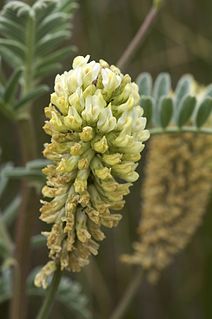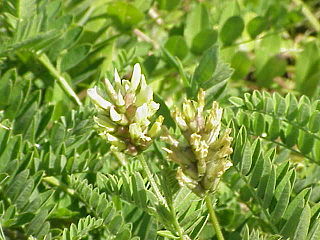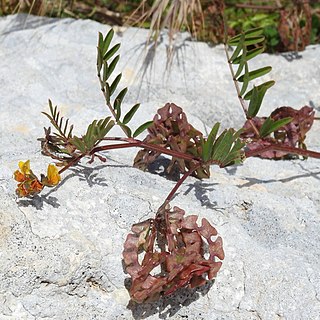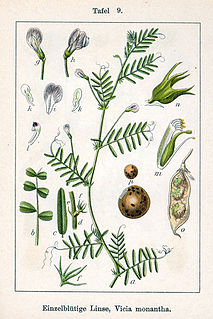
Astragalus pycnostachyus var. lanosissimus, the Ventura marsh milk-vetch, is a short-lived, herbaceous perennial in the pea family Fabaceae,

Astragalus pycnostachyus is a species of milkvetch known by the common name marsh milkvetch. It is endemic to the coastline of California, where it grows in wet saline habitat such as marshes.

Astragalus cicer, the chickpea milkvetch, chick-pea milk-vetch or cicer milkvetch, is a perennial flowering plant native to Eastern Europe, popularized and subsequently transported to areas in Southern Europe, North America, and South America. Cicer milkvetch exhibits legume-like qualities; the plant produces pods which harbor its seeds. Its flowers are usually of pale yellow tint, and as such, attract bumble or European honey bees for pollination. Growth often exceeds 0.6 meters, up to a height of 1 meter in length.

Astragalus drummondii is a species of flowering plant in the legume family known by the common name Drummond's milkvetch. The botanist Thomas Drummond first identified the plant during his travels in North America from 1825 to 1835, the year of his death. Astragalus drummondii is one of many plants named after him. Upon the return of samples collected by Drummond to England, his findings were published in Sir William Hooker’s Flora Boreali-Americana in 1840.

Astragalus danicus, known as purple milk-vetch, is a species of flowering plant in the family Fabaceae (legumes), which is native to Europe.

Astragalus sinicus is a species of milkvetch in the family Fabaceae. It is known under such common names as Chinese milkvetch and is in common use in farming as a green manure. It is not to be confused with Astragalus propinquus, the plant yielding Radix Astragali for Chinese medicine.

Ajuga iva is a species of perennial herb in the family Lamiaceae. They have a self-supporting growth form and simple, broad leaves. Individuals can grow to 5 cm. Subspecies include Ajuga iva subsp. iva and Ajuga iva subsp. pseudoiva.
Astragalus boeticus is a species of annual herb in the family Fabaceae. They have a self-supporting growth form and compound, broad leaves.
Astragalus sesameus is a species of plants in the family Fabaceae.
Coronilla scorpioides is a species of annual herb in the family Fabaceae. They have a self-supporting growth form and compound, broad leaves. Individuals can grow to 20 cm tall.

Hippocrepis biflora is a species of annual herb in the family Fabaceae. Individuals can grow to 17 cm tall.

Hippocrepis ciliata is a species of annual herb in the family Fabaceae. They have a self-supporting growth form and compound, broad leaves and dry fruit. Individuals can grow to 17 cm tall.

Hippocrepis multisiliquosa is a species of annual herb in the family Fabaceae. They have a self-supporting growth form and compound, broad leaves. Individuals can grow to 24 cm tall.
Hypericum australe is a species of plants in the family Hypericaceae. Individuals can grow to 24 cm tall.

Lathyrus ochrus is a species of annual herb in the family Fabaceae. They are climbers and have compound, broad leaves. Flowers are visited by Old World Swallowtail and Oxythyrea funesta.
Vicia leucantha is a species of plants in the family Fabaceae.

Vicia monantha is a species of annual herb in the family Fabaceae. They are climbers and have compound, broad leaves.

Vicia peregrina is a species of annual herb in the family Fabaceae. They are climbers and have compound, broad leaves. Individuals can grow to 0.32 m.
Vicia parviflora is a species of annual herb in the family Fabaceae. They are climbers and have compound, broad leaves. Individuals can grow to 0.24 m.

Tripodion tetraphyllum is a species of annual herb in the family Fabaceae. They have a self-supporting growth form and compound, broad leaves. Individuals can grow to 0.2 m.














